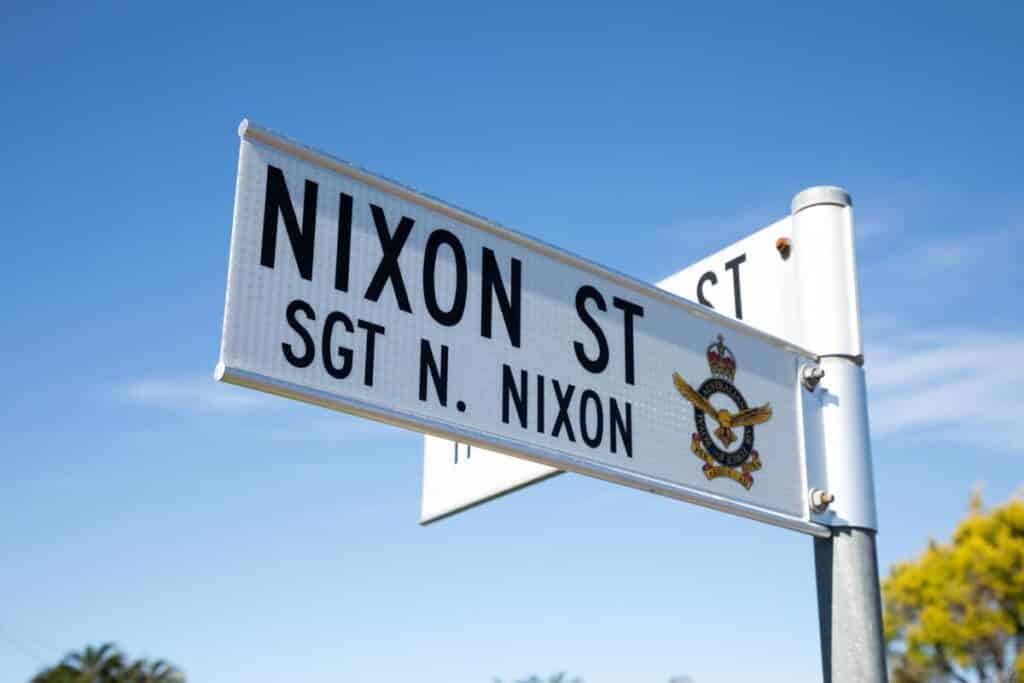
Nixon Street in Kepnock was named in Sergeant Noel Nixon’s honour in September 1957, and his WWII service has been commemorated through Council's Streets of Remembrance program.
The program sees the badge under which local veterans served added to the signs of Bundaberg Region streets named their honour.
Noel Louis Nixon was born in Bundaberg on 18 September 1914 and as a child moved with his family to live in Emerald, with the family later returning to Bundaberg.
He was working as a general store manager in Springsure, outside of Emerald, when he enlisted in the Royal Australian Air Force (RAAF) on 20 July 1941.
Noel started as air crew and undertook training through the Empire Air Training Scheme (EATS), which was a joint British, Australian and Canadian effort to train the thousands of pilots and air crew needed to fight the war.
As he undertook the flying training course, he progressed from air crew to Air Observer with the rank of Sargeant.
The training took him to bases around Australia, including Cootamundra, Evans Head, and Parkes, NSW.
He was stationed at No.3 Initial Training School in Sandgate, Queensland, and later the No.4 Service Flying Training School in Geraldton, Western Australia from 25 June 1942.
Accidental death
Sergeant Nixon was killed on 9 October 1942 when the Avro Anson aircraft he was travelling in accidently crashed near Clackline, Western Australia, just outside of Perth.
He was 28 years old.
Also killed in the accident were Flying Officer Lynton Vennel Howard Birt, Sergeant Kenneth Colin Hugo and Sergeant Geoffrey Lancaster Debenham, all from 68 Reserve Squadron based in Geraldton.
The aircraft was on a training mission from Cunderdin to Pearce air force base when it crashed soon after 1pm on to a rural property leased by Mr George Harvey.
The Geraldton Guardian and Express newspaper reported at the time that Mrs Harvey saw the aircraft flying close to the ground and feared it would hit her home.
After passing over the house, the aircraft crashed around 1.2km away, gouging long trenches into the rising ground.
Mrs Harvey hurried to the site but was unable to render assistance as the plane was on fire and the four crew had been thrown from the plane on impact and killed.
Machine gun ammunition that had been on board was ignited by the fire, adding to the noise of the crash and drawing people to the crash site from several miles around.
The rudder was found 18m away in the branches of a tree.
The plane was reduced to a smouldering pile of material and metal and was taken away by an Air Force salvage unit following an inspection by the Air Force Inquiry Board two days after the accident.
Crash memorial
In the months following the crash, members of the Clackline area community assembled a memorial in honour of the four airmen killed.
The memorial featured a cairn of granite and boulders with a jarrah cross into which the names of the deceased were carved.
The memorial became overgrown until it was restored and rededicated in 1984 by volunteers from the Perth branch of the RAAF Association, who went on to hold annual memorial services at the site.
The memorial is now surrounded by a small park on Avro Anson Road, Mokine, Western Australia.
Sergeant Nixon is buried in Perth War Cemetery and Annex, Perth, Western Australia, and included on the Australian War Memorial Roll of Honour and Bundaberg Civic Centre Memorial Portico.
He was awarded the Air Observer Badge on 23 May 1942 and the Australia Service Medal 1939-45.
Noel Louis Nixon, Royal Australian Air Force, Service Number: 414073
Information on Flight Sergeant Nixon’s life and service is from the Australian War Memorial, the National Library of Australia, Monument Australia and National Archives of Australia.
Australian Heritage Festival
To celebrate the Australian Heritage Festival theme ‘connection’ Bundaberg Regional Council is highlighting the region’s history.
Held from 18 April to 19 May, the National Trust festival celebrates Australia’s rich and diverse stories, strengthens cultural and historical ties, and encourages the community to forge new bonds.
Read more stories in the series:




